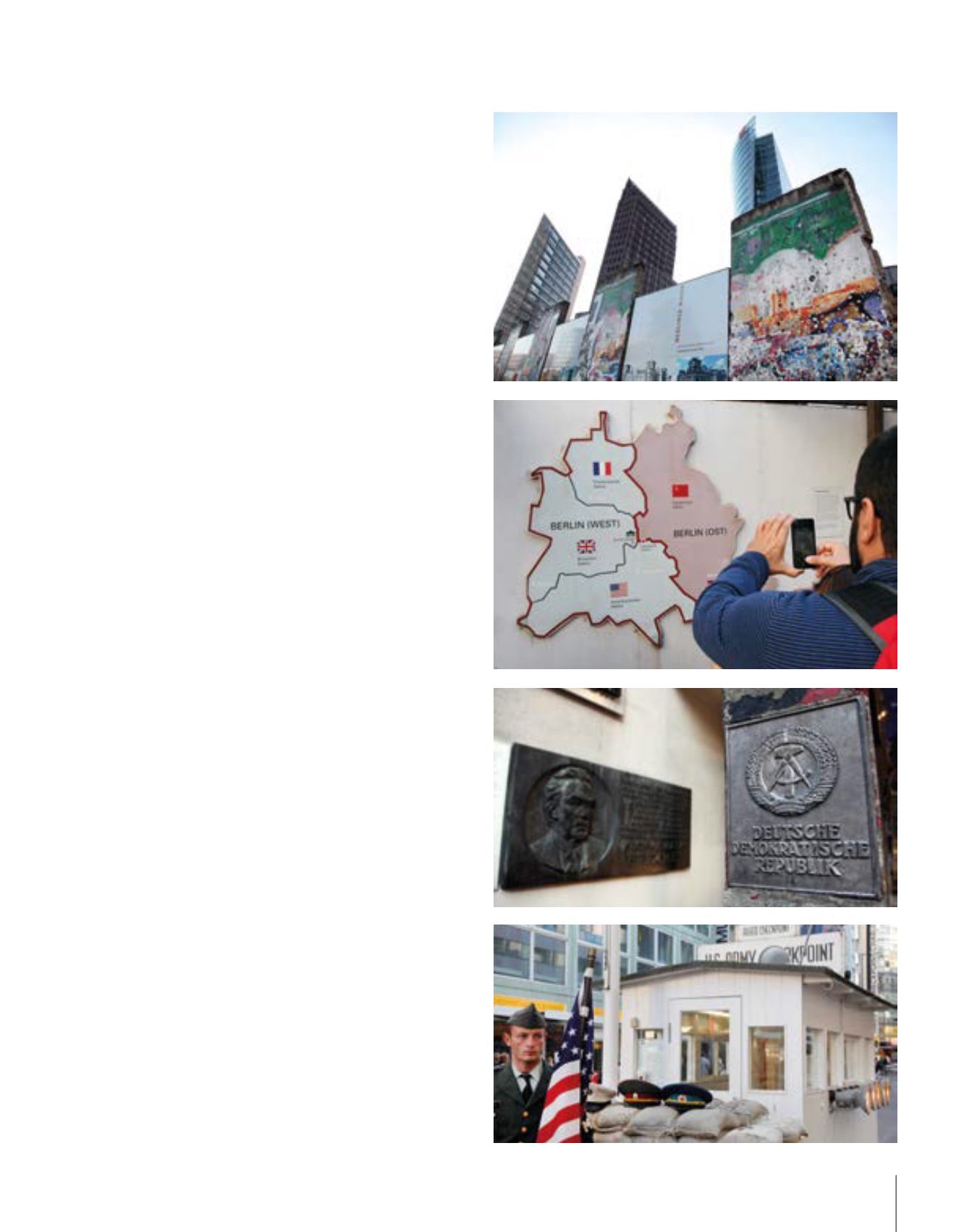
111
ilan edilmiş. Ancak Batı Berlin
“de facto” Almanya Federal
Cumhuriyeti’ne ait olduğundan
özel haklar tanınmış. Berlin’in
doğusu ve batısı arasındaki
geçişler -en meşhurları
Amerikan sektöründeki geçişte
yer alan, günümüzün turist
magneti Checkpoint Charlie
olmak üzere- bazı kontrol
noktalarından ve sadece bazı
yetkililer için mümkünmüş.
Sivillerin Batı Berlin’e geçişi
tamamen yasaklanmış ve sınır
bölgelerine keskin nişancılar
konulmuş. Yine de sadece
Berlin metrosunu kullanarak
1955 yılına kadar, ayrılığın
ardından Batılı müttefiklerinin
de desteğiyle büyük bir
ekonomik büyüme yakalayan
Batı Almanya’ya 270 bin insan
kaçmayı başarmış. Nitekim
Sovyetler Birliği de, Batı Berlin’i
Doğu Almanya sınırları içinde
bir fesat yuvası, kapitalizmin
kalesi, karşı propaganda
merkezi olarak gördüğü
için Berlin Duvarı’nı örmeyi
çözüm olarak benimsemiş.
12 Ağustos 1961 tarihinde
Berlin Duvarı’nın yapımına
başlanmış ve bir gün içerisinde
geçici inşası tamamlanmış.
Bugün hikayeleriyle tarih
kitapları ve müzelere konu
olan, duvara komşu binaların
çatı ve pencerelerinden
atlayarak, tüneller kazarak,
duvarı otomobiliyle yıkmaya
çalışarak, kontrol noktasındaki
devriye görevini bırakıp
koşarak geçenler gibi
istisnalar dışında Berlinlilerin
doğudan batıya geçişi en
katı yöntemlerle engellenmiş
ve imkansız hale gelmiş.
Berlin Duvarı da Soğuk Savaş
yıllarındaki demir perdenin
somut ve vücut bulmuş
hali olarak 27 yıl boyunca
aslında sadece Doğu ve Batı
Berlin’in değil, Komünizm ve
Kapitalizm mücadelesinin
sınırlarını da çizmiş. Zamanın
imparatorluk merkezi olan
Mitte ile birlikte, Berlin’i inşa
eden mimar Karl Friedrich
Schinkel’in tasarladığı binalar,
cross from east to west was
stopped with severe methods
and became impossible. The
Berlin Wall turned out to be the
embodiment of the iron curtain of
the Cold War years for 27 years,
drawing the line not only between
East and West Berlin but also
the fight between Communism
and Capitalism. The old imperial
center Mitte, buildings designed
by architect Karl Friedrich who
built Berlin, embassies, palaces,
almost all of the museums
including the Bergamo Museum
where the Temple of Bergamo
smuggled from Turkey is
displayed, they were all in the
eastern part of the city.
The fate of the iron curtain
and the wall is known. With
perestroika, the border policies
of Eastern Bloc Countries
became more flexible, enabling
East Germans to cross to
West Germany through other
countries, the Wall was rendered
obsolete. Upon realizing this,
the East German government
announced its decision to
demolish the Wall in November
9th, 1989. Starting from the
Brandenburg Gate all barricades
and check points were removed
and within an hour hundreds
of thousands of Germans piled
up on both sides and the Wall
of Shame was buried in history.
Before too much time had
passed, in October 3rd, 1990,
both sides of Germany reunited
and Berlin regained its integrity
as a state city, becoming the
capital city of Federal Republic of
Germany.
Turkish Population
Of course when we say Berlin,
we are talking about a European
city where relatives of some of
our readers probably live. The
source of Germanic Chocolates
from our childhood. Currently
around 200,000 Turks of three
generations live in Berlin. Though
this number seems insignificant
within the 2.7 million Turkish-
origin people living in Germany,
it is the largest number of Turks
living in a city outside Turkey
and also the largest foreign
population in Berlin. The densest
Turkish population in Berlin is
the Kreuzberg district. Among
the 150 thousand people that
live in Kreuzberg, 50 thousand of
them are foreign-origin people,


